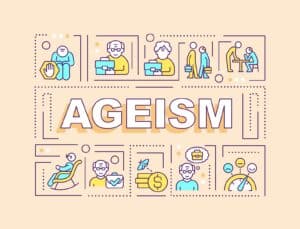With people living longer and working beyond the traditional retirement age, our workforce is changing. At the same time, you can’t open a newspaper without reading about labour shortages. Let that sink in for a moment.
The way I see it, this new reality calls for a new way of attracting and retaining your valued employees. Older workers bring valuable skills, experience, and wisdom to the workplace but face unique challenges and needs.
How can employers attract, retain, and motivate older workers in ways that benefit both the organisation and the workers?
This article will explore some of the best practices and strategies for engaging older workers in continuous development, creating flexible and respectful work environments, and fostering intergenerational cooperation and learning.
Challenges faced by senior workers
Saying it out loud won’t make it any easier. After decades of ageism, where people over the age of 45 were told they were ‘too old’ or ‘overqualified’, it will take a complete turnaround to get all the noses pointing in the same direction once again.
Older candidates need to be reassured that they’re valued again. In contrast, younger people need to relearn to appreciate the benefits of having colleagues over 45.
Bias and age discrimination
Age discrimination is a critical issue that can impact both the young and the old in the workplace.
Older workers may face age discrimination, stereotypes, and negative attitudes, assuming they are less flexible, productive, or motivated to learn new skills. This can affect their career opportunities, access to additional training, and job satisfaction.
Enter the stereotype grey-haired person, counting their days to retirement.
Addressing these biases head-on through awareness training and inclusive policies is essential for creating a culture where workers feel appreciated and valued for their contribution.
Benefit packages for all ages
And then there’s the benefits package. In recent years, we have moved away from the obligatory Christmas package to a comprehensive benefits menu. Unfortunately, the focus has been on retaining young talent. It hasn’t been as much about supporting people later in life.
More focus on flexibility

It’s a given that senior workers tend to have more responsibilities in terms of informal care, neighbourly help, pitching in with their children’s young families, etc. While these hardly require full-time availability, they are often the primary reason senior workers stop working altogether. So, there’s a world to win here!
While there’s a lot of attention paid to flexibility for younger workers, the issue could use some repositioning. After all, flexibility can be a great thing for people of all ages. With flexible working arrangements, senior workers aren’t forced to choose between career and personal commitments.
Allowing your older workers to plan their lives as they see fit can quickly reduce the risk of losing them to early retirement, health issues or caring responsibilities. Can you imagine anything having such a profound effect on the stability of a business?
Health and well-being: What strategies to implement for a healthy ageing workforce
Older workers may experience different health problems because they’re in a different phase of life. In their phase, situations such as (problematic) pregnancy, extensive fertility and parental leave are rare. And what are the chances of childcare emergencies and the infamous sleepless nights of new parents? Not very likely, I’d say.
While those life events are well catered for, not much thought is given to specific barriers that may arise later in life. Entering your 50s, disabilities or chronic conditions may be more common, requiring adaptations or accommodations. And then there is the healing power of personal growth and development. Don’t ever underestimate that!
Ready for some serious rethinking? Let’s dive in.
Consider facilitating medical self-care in the workplace
Older workers may have more health issues or chronic conditions that require regular check-ups or treatments. Want an example? People with diabetes need to check their blood sugar levels regularly. Facilitating this by making a private, comfortable room available wins by all accounts.
As a bonus, this space can double or even triple as a stimulus-free environment for neurodivergent employees and an area where young mothers can pump undisturbed.
Accommodating your employees’ needs to care for their health without compromising their work performance will greatly improve their well-being and productivity.
The benefits of training and developing new skills

Investing in training and building new skills and competencies is a thing of all ages. Of course, as the exception that proves the rule, there will surely be older people who do not want to develop new skills and are against any newfangled technology. Yet, particularly if you offer your staff a challenging and fulfilling environment, older people will usually be just as eager to take on new developments as the next person.
Why not give them an equal chance to reskill or upskill and even become experts in your trade’s rapidly changing technology and work practices?
Providing them with these opportunities helps them remain employable and competitive in the labour market and, at the same time, boosts their self-confidence and motivation to stay with your company.
Creating a healthy and safe culture
What do I mean by that? There are many ways to create a culture where it’s the norm to live a healthy life. And with the right incentives, management can positively influence the development of this culture. Let’s look at some examples:
✔ Aim to support healthy working. This means making work tasks, processes and environments fit the abilities and needs of individual employees.
✔ Flexible working options such as part-time, remote, or job-sharing can reduce stress levels. They allow both older and younger workers to balance work and personal demands.
✔ Consider supporting healthy lifestyles by promoting wellness programmes such as physical activity and organising nutrition and mental health workshops. You might also consider setting up a staff restaurant, where healthy lunch options can be sponsored.
All these suggestions will not only encourage older workers to take care of their physical and mental health but will also benefit younger generations.
Ergonomic solutions enabling a more diverse workforce
Many people, including, but certainly not limited to, older people, may experience limitations in their physical or cognitive functioning. Let us not define them by their limits. This attitude is outdated, and this questionable luxury is no longer viable.
By providing your employees with modifications where needed, such as ergonomic equipment, assistive devices, or task adjustments, you can help them perform their work safely and effectively. Imagine all the highly skilled workers you can keep this way!
Also, it’s well-known that having your skills, experience, and gained knowledge recognised and appreciated does miracles for your self-esteem and engagement.
Mentorship and knowledge transfer

When experienced staff leave a company, it usually means a loss of knowledge and continuity. It’s a shame if this is due to a lack of cross-generational thinking.
Let that sink in for a moment. Ready to know more?
Access to a valuable source of knowledge and experience
There are clear benefits to a more diverse workforce. While younger workers are quicker learners and more energetic, other skills are developed later in life.
Many studies have shown that people over 50 are more likely to make the right decisions and are less prone to negative emotions. Let’s accept, without going overboard, that there is a reason why the average age of the chief executive of the world’s 100 largest companies is 63.
We have a lot to gain from allowing older workers, armed with their experience of the organisation and the specific requirements of the role, to guide your emerging talent within the company.
Not only does it help with the onboarding process and ensure that critical knowledge is retained, but it also gives mentors a sense of purpose and commitment.
It also encourages cross-generational collaboration and learning. Older workers can share their knowledge and skills with younger workers. In turn, the younger workers can offer a fresh point of view on the way things have always been done.
Conclusion

Effectively managing an ageing workforce means adapting to their specific needs and strengths. And why not? We already do this for employees in earlier stages of life.
It means tackling age discrimination, providing flexible working options and supporting health and well-being.
By encouraging continuous skills development and cross-generational mentorship, the whole organisation benefits from the wealth of valuable experience and knowledge of older workers, improving overall organisational performance.
Struck by the style and impact of this article? Imagine what a bespoke, compelling story can do for your brand! I specialise in creating engaging, well-researched articles that make you stand out as an industry expert.




